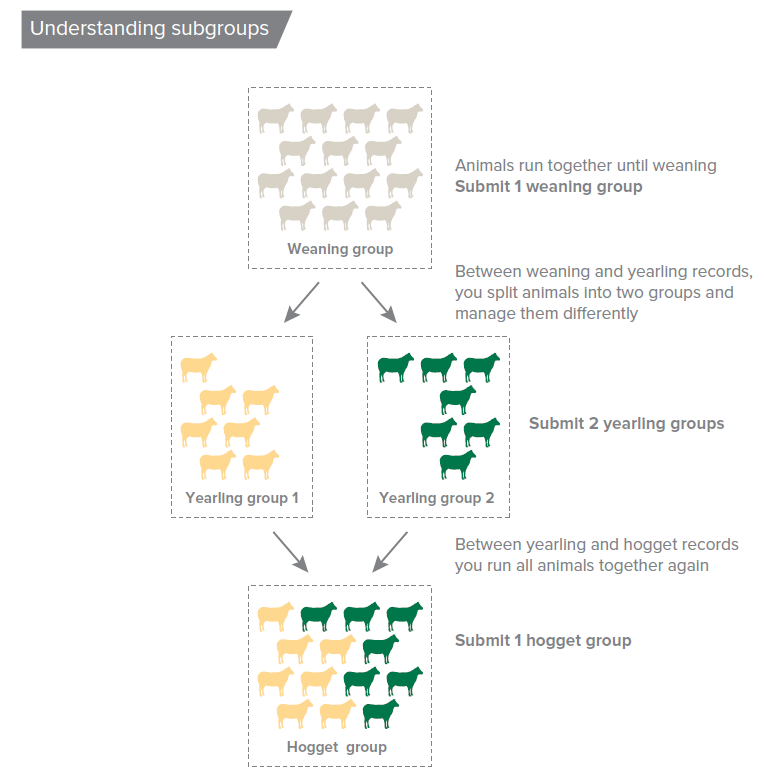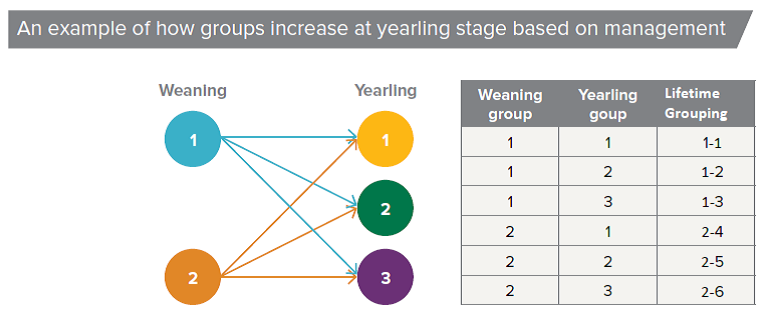Management groups
Sheep Genetics needs to know how animals are managed to account for performance differences that not related to their genetics. The information should include if groups within the flock are managed differently or if you do something to them which will impact their performance.
The management group submitted with a measurement refers to how an animal was managed prior to the measurement being recorded.
Animals should be placed in a different management group in your submission if their performance between measurements has been impacted by a difference in the environment or management, such as:
- Differences between paddocks
- Preferential feeding
- Illness/injury.
How do I record groups?
Step 1 – birth groups
Record animals based on how their mothers were managed during pregnancy. For example, if ewes were lambed down in different paddocks, with different feed availability or shelter, then the birth group of lambs should reflect the paddock they were born in.
Step 2 – sub management group at each age stage
At each age stage, include any subgroup (based on management) changes since the previous measurement.
For example, feeding lambs differently between weaning and post-weaning.
If you manage animals in different paddocks but the paddocks have similar history and feed available, you do not have to create subgroups based on paddocks.
Wethers and grouping
If you retain and measure wether lambs, these wethers must be sub-grouped separately to their ram contemporaries, as castration is a management activity that will impact performance.
Do you need to keep groups separated for life when you submit?
No, the evaluation keeps track of this for you.

How does Sheep Genetics make lifetime groups?
The information you send Sheep Genetics about groups is combined to make sure they are properly represented across an animal’s life.
The figure below shows an example where the number of groups increase at yearling stage. In this example, there were two weaning groups that were split into three yearling groups. While there were three groups at the yearling age stage, Sheep Genetics split the data into six lifetime groups to reflect any performance differences based on their past.

Embryo transfer impacts grouping
If you are using ET, it is important to note that these lambs are grouped separately in the evaluation to any natural or AI conceived lambs. This is due to the influence of the pharmaceutical intervention on the performance of these lambs.
Best practice ET for the genetic evaluation:
- Ensure there are multiple sires included in the ET program
- Ensure that there is a common sire between the ET program and the natural/AI joining (refer to Linkage section)
- Ensure there are multiple progeny of each sex from each sire in the ET program (refer to Effective Progeny section)
Missed measurements
Where an animal is not present for a recording event that the rest of its group is measured at, this animal grouped separately from the cohort from that point in its life onwards.
For example, you are body weighing a group of ram lambs, however one ram was missed and left in the paddock and therefore did not have a weight recorded on the same day as his contemporaries. This one ram will then be grouped out for the remainder of its life, even if it is put back in with the original group of rams and is present for the following measurement.
This occurs because the evaluation does not know why an animal wasn’t present at recording, which may be due to accidental reasons (such as mis-mustering or mis-read of a tag) or deliberate (such as the animal getting through a fence and therefore being under different management conditions or treating an unwell animal).
Complete cohort recording is important to limit the impact and prevalence of missed measurements.
Sheep Genetics QA protocol
Management group checklist:
|
How are these groups analysed?
Groups and subgroups form the foundation of contemporary groups, which are the groups used in the evaluation. These contemporary groups are built based on:
- Management group supplied (and prior management grouping, or lifetime grouping)
- Date of measurement
- Flock code
- Sex
- Year drop
The evaluation further splits based on range in age to limit any bias caused by spread in age. For early-in-life traits, this split is in increments of 35 days, and from postweaning, where birth date has comparatively less impact on performance, splits based on 70 day increments.
Important
|
Effective progeny numbers
It is important there are enough animals in each contemporary group to provide useful data for genetic evaluation. Each sire must also have enough progeny in a group to have effective progeny numbers.
It is also important to have adequate sire representation within each contemporary group. It is recommended that you aim for a minimum of 10 progeny from each sire of the same sex within each contemporary group to maintain effectiveness of data.
Having more sires in a contemporary group also increases the effectiveness of the records because more genetics are being compared under the same environmental conditions.
If you are interested in traits which are recorded later in life, such as adult or reproduction traits, it is important to ensure that these older groups have effective progeny numbers.